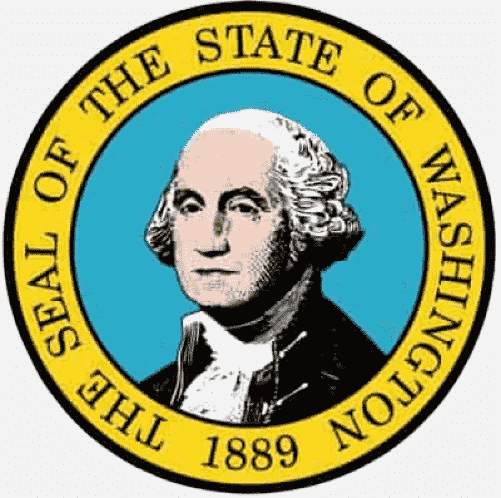 State Flag |  State Seal |
Washington is a state in the Pacific Northwest region of the United States. It is bordered by the Pacific Ocean to the west; Canada to the north; Idaho to the east; and Oregon to the south.
- ABBREVIATION: WA
- NICKNAME: The Evergreen State
- POPULATION: 7,958,180 (2024 est.)
- CAPITAL: Olympia
- STATE BIRD: Willow Goldfinch
- STATE FLOWER: Coast Rhododendron
- AREA: 71,362 sq. mi.
- TIME ZONE: Pacific
- ENTERED UNION: Nov. 11, 1889
- ALTITUDE: High, 14,411 ft. Mount Rainier
- CLIMATE: Cool summers, mild winters along coast and Puget Sound; hot summers, cold winters on inland plateau. Heavy rainfall on windward slopes of the Olympics; dry on inland plateau.
The glaciated volcanic peaks of the Cascade Range form a great barrier between the moist valleys of the west and the dry inland plateaus of the east. In the west the Washingtonians run factories, fisheries, dairies, and manage timberland; in the eastern “Inland Northwest” they grow fruit and wheat.
The sea strongly influences the western economy: a 200 mile long extension of the Pacific through Juan de Fuca Straight and Puget Sound gives many of the state’s cities uniquely sheltered coastlines far inland.
On the semi-arid eastern plateau, the U.S. government has created a 130 mile-long body of water, Lake Roosevelt, which backs up from the mighty Grand Coulee Dam. One of the largest hydroelectric projects in the Western Hemisphere, Grand Coulee supplies power and irrigation throughout the vast Columbia Basin.

Mt. St. Helens, Washington
First explored in 1792 by the British Captain George Vancouver, who entered Puget Sound, and Robert Gray, an American who discovered the Columbia River, Washington still has areas of unspoiled beauty.
Mount Rainier National Park contains 25 active glaciers. At 14,410 feet, Mount Rainier is the most prominent peak in the Cascade Range (View Mount Rainer webcams). The moss-draped trees of Olympic National Park present a green luxuriance reminiscent of the rain forests of South America.
Fun Facts:
- Washington is the only state named for a President.
- The first Father’s Day was observed in Spokane in 1910.
- The northernmost point in the contiguous United States is Cape Flattery on the Olympic Peninsula.
- Sam Hill built a concrete replica of England’s Stonehenge on a bluff overlooking the Columbia River as a memorial to the soldiers from Klickitat County who fought and died in World War I.
- The Olympic Peninsula is home to the only temperate rain forest in the lower 48 states. It receives 12 to 14 feet of rain each year. The forest is dominated by Sitka Spruce and Western Hemlock, some of which are 300 feet high and 23 feet around.
- Washington has more glaciers than all of the other 47 contiguous U.S. states combined.
History:
The history of Washington state is a story of natural beauty, Indigenous heritage, exploration, settlement, economic transformation, and innovation. Located in the Pacific Northwest, Washington has evolved from a land inhabited by Native American tribes to a center of global technology, agriculture, and environmental leadership.
Long before European contact, the region now known as Washington was home to many Native American tribes, including the Coast Salish, Yakama, Spokane, and Chinook peoples. These tribes developed rich and diverse cultures based on fishing, hunting, and trading.
The abundance of salmon, forests, and rivers shaped their economies, social systems, and spiritual beliefs. Even today, Native communities remain an important part of Washington’s identity and continue to protect their traditions and lands.
European exploration began in the 18th century. In 1775, Spanish explorers reached the Washington coast, followed soon by British explorer Captain James Cook and, later, George Vancouver, who mapped much of the coastline and named many geographical features.
American interest grew after the Lewis and Clark expedition passed through the region in 1805 as part of their journey to the Pacific Ocean.
During the early 19th century, fur trading became the dominant industry in Washington. The Hudson’s Bay Company established trading posts, including Fort Vancouver in 1825, which became a major center of commerce. American settlers began arriving in greater numbers via the Oregon Trail in the 1840s, seeking fertile farmland and new opportunities.
In 1846, the Oregon Treaty between the United States and Britain set the U.S.-Canada border at the 49th parallel, officially bringing Washington under American control. The Washington Territory was created in 1853, carved out of the larger Oregon Territory.
As settlers moved in, tensions and conflicts with Native tribes increased, leading to several violent confrontations, including the Yakama War of 1855–1858.
Washington became the 42nd state in the Union on November 11, 1889. Statehood brought rapid growth, especially in cities like Seattle, Tacoma, and Spokane. Timber, mining, and agriculture fueled the early economy, along with the development of railroads that connected Washington to the rest of the country.
The 20th century brought new challenges and transformations. During World War II, Washington played a key role in shipbuilding, airplane manufacturing (especially through Boeing), and nuclear research at the Hanford Site, part of the Manhattan Project. After the war, the aerospace industry grew rapidly, making Seattle a hub of innovation and jobs.
In the late 20th and early 21st centuries, Washington emerged as a global center for technology and business. Companies such as Microsoft, Amazon, and Starbucks were founded in the state and contributed to its economic boom and international reputation.
Today, Washington is known for its environmental consciousness, diverse population, and strong economy. It blends natural wonders—like the Cascade Mountains, Puget Sound, and rainforests—with cutting-edge industries and progressive politics.
From its Native heritage to its role in shaping the digital age, the history of Washington reflects both the beauty and complexity of the American experience.